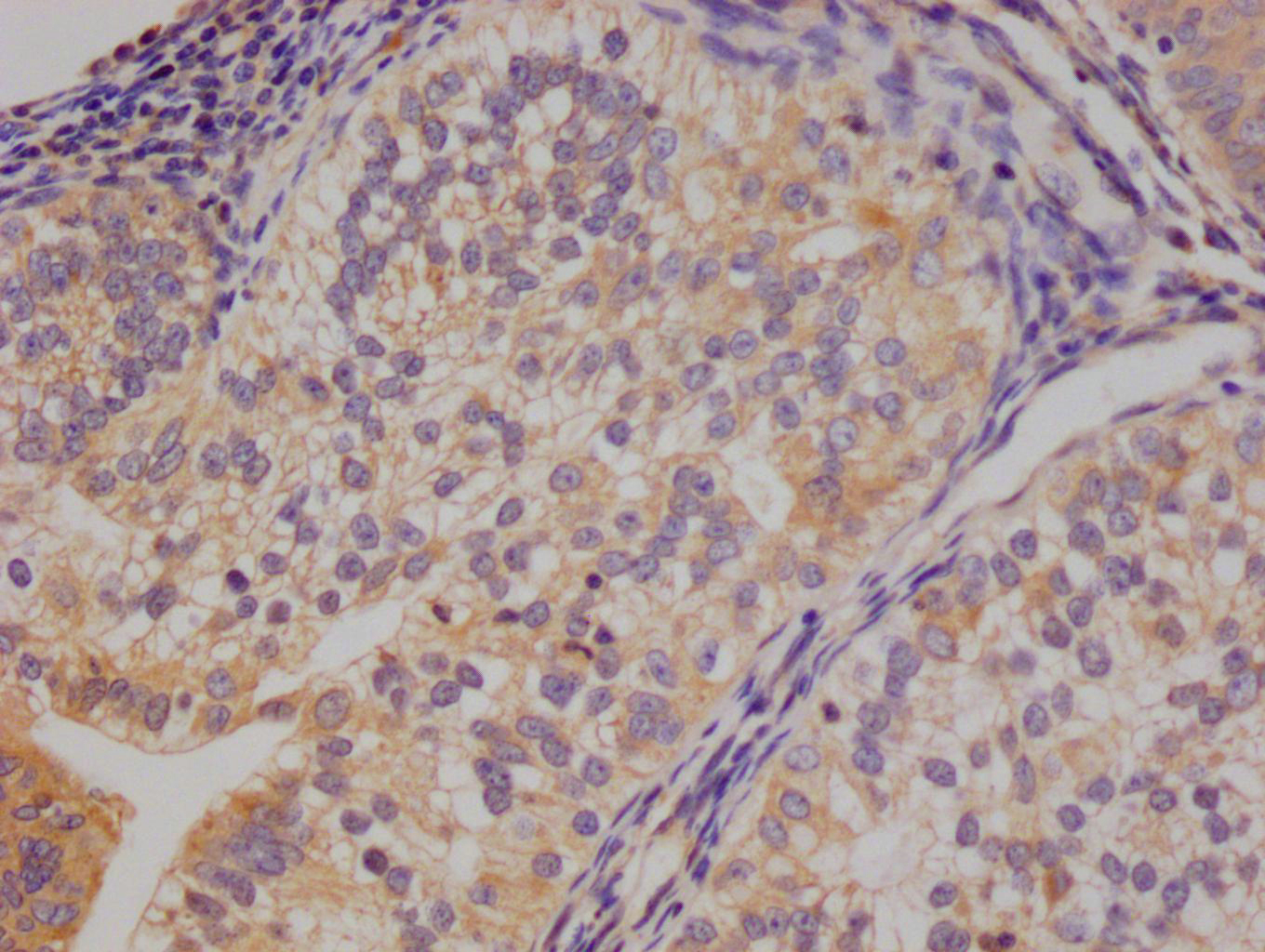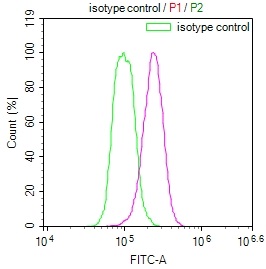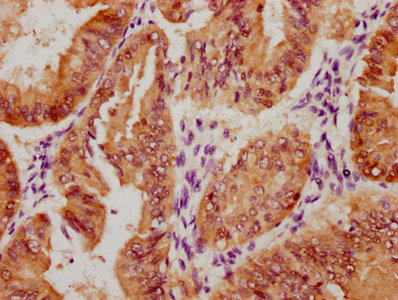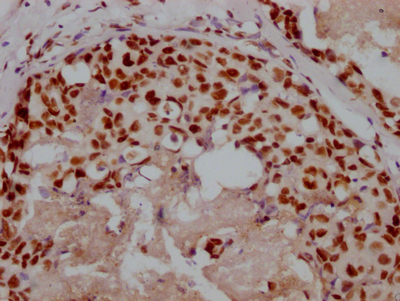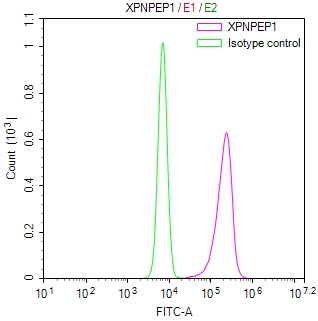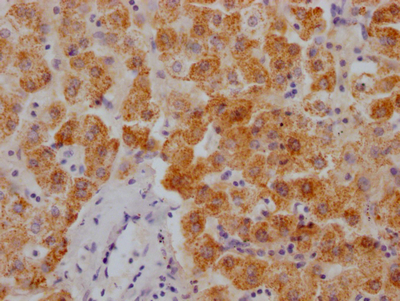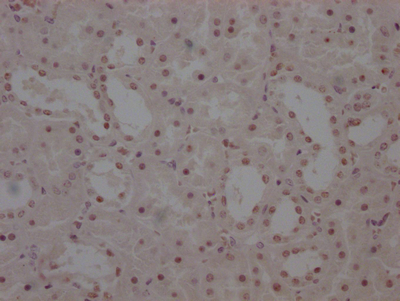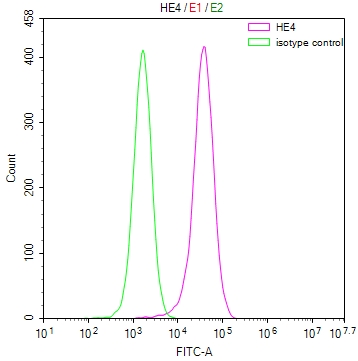PIP Antibody, HRP conjugated
-
中文名稱:PIP兔多克隆抗體, HRP偶聯(lián)
-
貨號(hào):CSB-PA018020LB01HU
-
規(guī)格:¥880
-
其他:
產(chǎn)品詳情
-
產(chǎn)品名稱:Rabbit anti-Homo sapiens (Human) PIP Polyclonal antibody
-
Uniprot No.:
-
基因名:PIP
-
別名:BRST-2 antibody; BRST2 antibody; GCDFP-15 antibody; GCDGP15 antibody; gp17 antibody; GPIP4 antibody; Gross cystic disease fluid protein 15 antibody; PIP antibody; PIP_HUMAN antibody; Prolactin induced protein antibody; Prolactin inducible protein precursor antibody; Prolactin-induced protein antibody; Prolactin-inducible protein antibody; SABP antibody; Secretory actin binding protein antibody; Secretory actin-binding protein antibody
-
宿主:Rabbit
-
反應(yīng)種屬:Human
-
免疫原:Recombinant Human Prolactin-inducible protein (29-146AA)
-
免疫原種屬:Homo sapiens (Human)
-
標(biāo)記方式:HRP
-
克隆類型:Polyclonal
-
抗體亞型:IgG
-
純化方式:>95%, Protein G purified
-
濃度:It differs from different batches. Please contact us to confirm it.
-
保存緩沖液:Preservative: 0.03% Proclin 300
Constituents: 50% Glycerol, 0.01M PBS, PH 7.4 -
產(chǎn)品提供形式:Liquid
-
應(yīng)用范圍:ELISA
-
Protocols:
-
儲(chǔ)存條件:Upon receipt, store at -20°C or -80°C. Avoid repeated freeze.
-
貨期:Basically, we can dispatch the products out in 1-3 working days after receiving your orders. Delivery time maybe differs from different purchasing way or location, please kindly consult your local distributors for specific delivery time.
-
用途:For Research Use Only. Not for use in diagnostic or therapeutic procedures.
相關(guān)產(chǎn)品
靶點(diǎn)詳情
-
基因功能參考文獻(xiàn):
- Unusual N-type glycosylation of salivary prolactin-inducible protein (PIP): multiple Lewis(Y) epitopes generate highly-fucosylated glycan structures. PMID: 29858715
- that GATA3 is a very sensitive marker for primary genital extramammary Paget diseases and is more sensitive than gross cystic disease fluid protein 15 PMID: 28693610
- monoclonal antibodies to GATA-3 are very sensitive reagents for the identification of breast CA, surpassing antibodies to GCDFP-15 and mammaglobin A, and offer a significant improvement in identifying TNBCs PMID: 26447897
- good coincidence was observed between primary and metastatic tumor GATA3 expression (kappa value = 0.826 >0.75) as compared with the coincidence of GCDFP15 (kappa value =0.492 <0.75) and mammaglobin (kappa value =0.593 <0.75) PMID: 28038704
- High expression of GCDFP-15 is associated with molecular apocrine breast cancer. PMID: 26711786
- While highly expressed under pathological conditions of the mammary gland, including breast cancers, PIP is expressed in very few other cancers. Although the function of PIP is not well elucidated, numerous studies suggest that its primary role may be related to host defense and immune modulation. Studies in Pip null mice suggest that PIP may play a similar immune-regulatory role in breast cancer. [Review] PMID: 27602994
- novel marker GATA3 stains a significantly higher proportion of both primary and metastatic breast carcinomas than GCDFP15 or mammaglobin with stronger and more diffuse staining, helpful in cases with small tissue samples PMID: 25906123
- In summary, this study suggests that PIP expression regulates the process of cell adhesion in breast cancer. PMID: 26585492
- GCDFP15 in stratum corneum is a potential marker for dysregulated sweating in atopic dermatitis. PMID: 25919462
- The commonly used breast carcinoma biomarkers vary in their prognostic implications. GCDFP-15 independently indicated a favourable prognosis. GATA-3 and MGB were not associated with outcome. PMID: 25425335
- Data indicate the potential role of Gross cystic disease fluid protein-15/prolactin-inducible protein (GCDFP-15/PIP) as a biomarker for keratoconus (KC)disease. PMID: 25405607
- Prolactin-induced protein mediates cell invasion and regulates integrin signaling in estrogen receptor-negative breast cancer. PMID: 22817771
- GCDFP-15 expression is higher in tumors with favorable prognostic features. GCDFP-15 expression is further a frequent feature of androgen receptor positive tumors and the molecular apocrine subtype. PMID: 25070172
- PIP is a breast cancer-related protein that is expressed in a majority of breast tumors and has a significant function in the biology of this disease. [review] PMID: 25472539
- we found that HER2 or GCDFP15 protein overexpression is a sensitive and specific tool to differentiate MA from BL in the context of ER negative tumors. PMID: 23663520
- The roles of PIP in the related T47D breast cancer cell line, were investigated. PMID: 23755096
- PIP is required for cell cycle progression in breast cancer and provides a rationale for exploring PIP inhibition as a therapeutic approach in breast cancer that can potentially target microtubule polymerization. PMID: 24862759
- Report GCDFP15 expression in metastatic basal-like triple negative breast carcinomas. PMID: 24272937
- AZGP1 and PIP were found in significantly lower levels in invasive breast tissue. PMID: 24114735
- GCDFP-15 was associated significantly with a breast cancer profile of good prognosis tumors. PMID: 23332923
- Gross cystic disease fluid protein-15 and mammaglobin A expression determined by immunohistochemistry is of limited utility in triple-negative breast cancer. PMID: 22963676
- Interaction analysis identifies semenogelin I fragments as new binding partners of PIP in human seminal plasma PMID: 23085372
- GCDFP-15 alone is not a useful marker to detect the metastasis of basaloid type breast cancers. PMID: 23011826
- expression was down-regulated in azoospermia, indicating that PIP may be a plausible marker of azoospermia PMID: 22724438
- The first report of native human serum albumin (HSA)-PIP complex formation in seminal plasma. PMID: 22209935
- abnormal development of the prepuce in hypospadias is associated with variation in PIP expression PMID: 21883842
- Data suggest that Runx2 controls a positive feedback loop between androgen signaling and PIP, and pharmacological inhibition of PIP may be useful to treat PIP positive tumors. PMID: 21809344
- Most basal-like breast carcinomas and unclassified triple-negative carcinomas are negative for mammaglobin and gross cystic disease fluid protein 15. PMID: 21411781
- expressed on a small subset of primary lung adenocarcinomas PMID: 19620839
- Intragenic amplification and formation of extrachromosomal small circular DNA molecules from the PIP gene on chromosome 7 in primary breast carcinomas PMID: 11992405
- different conformations and/or tissue-specific posttranslational modifications of the proteins, although their primary structure was identical by MS/MS analysis PMID: 12755619
- Forms a protein complex with PIG-F and is involved in the conversion of phosphatidylinositol glycans. PMID: 15632136
- The sensitivity of mammaglobin is equal or superior to that of GCDFP-15 for investigation of breast carcinoma. PMID: 18251583
- analysis of the novel complex formed between zinc alpha2-glycoprotein (ZAG) and prolactin-inducible protein (PIP) from human seminal plasma PMID: 18930737
- Both MGB1 and GCDFP-15 are specific markers for metastatic breast carcinomas in cell block fluid specimens (88 vs. 96%). PMID: 19217055
- importance of a regulatory subnetwork associated with PIP expression in which STAT5 appears as a potential transcriptional regulator PMID: 19262752
- PIP(alternate name GCDFP-15, gp17) is a secretory marker of apocrine differentiation in breast carcinoma. It is an aspartyl proteinase with specificity restricted for fibronectin. PMID: 10713110
顯示更多
收起更多
-
亞細(xì)胞定位:Secreted.
-
蛋白家族:PIP family
-
組織特異性:Expressed in pathological conditions of the mammary gland and in several exocrine tissues, such as the lacrimal, salivary, and sweat glands.
-
數(shù)據(jù)庫(kù)鏈接:
Most popular with customers
-
-
YWHAB Recombinant Monoclonal Antibody
Applications: ELISA, WB, IHC, IF, FC
Species Reactivity: Human, Mouse, Rat
-
Phospho-YAP1 (S127) Recombinant Monoclonal Antibody
Applications: ELISA, WB, IHC
Species Reactivity: Human
-
-
-
-
-


